#simbirsk
Photo
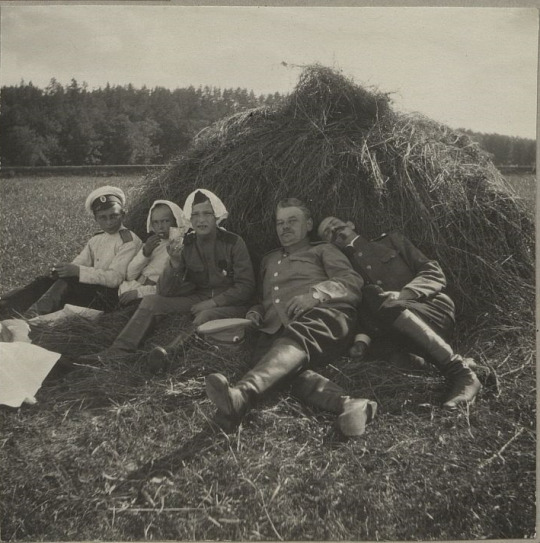

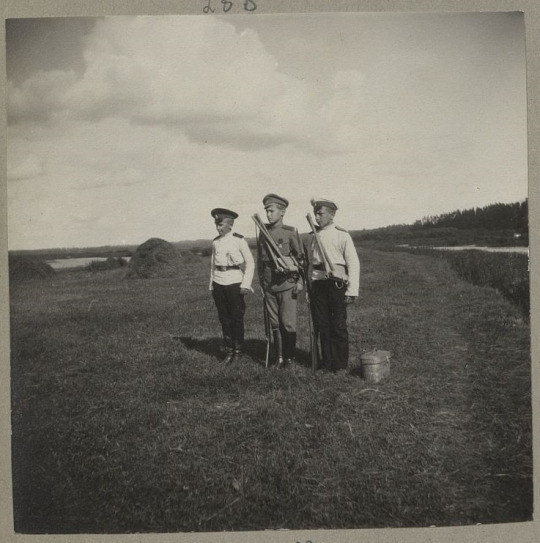

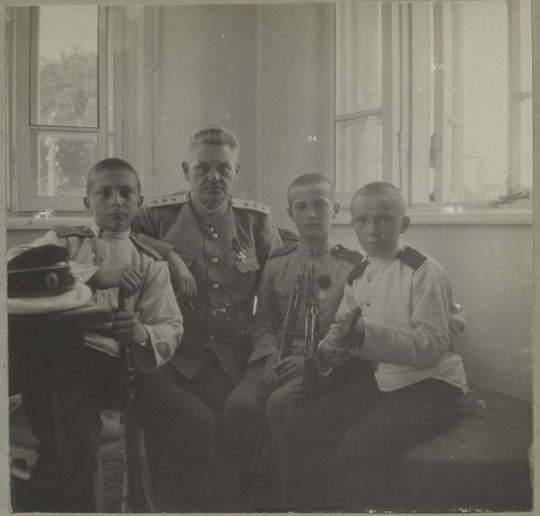
Cadets Evgeni Makarov and Vasili Agaev - Part VII
(Continuation of the 1916-1917 Album of Grand Duchess Anastasia Nikolaevna)
These five photographs come from the Album of Grand Duchess Anastasia Nikolaevna (Circa. 1916-1917). If one peruses through the albums (generously scanned by Ilya Grigoriev), you can see that copies of the same photograph were pasted into various albums belonging to the Grand Duchesses, as well as, Their Majesties.
Cadets Makarov and Agaev (affectionately referred to as “Zhenya” and “Vasya” by the Tsesarevich, and his family), came to Stavka at Mogilev (General Headquarters) in mid-late Summer of 1916. In the Tsesarevich’s diary entries, his times spent at “HQ” were some of the happiest in his life. He felt the most freedom there as opposed to Tsarskoe Selo where he was surrounded always by “fussy women.”
This is the end of photographs of the two boys, in the way of the Imperial Family’s private photograph albums. In other albums and funds (archives) are other photographs. I plan on sharing these too (though they probably have already been posted on here xD) - but I need some shut-eye!
Good night everyone (actually, good morning!), hope you enjoyed this series of posts. ^_^
________________________________________________________________
Photographs:
1. Tsesarevich Alexei Nikolaevich with Cadets Evgeni Makarov (left) and Vasili Agaev (far left), as well as, Petr Petrov (right) and Pierre Gilliard (far right).
2. Tsar Nicholas II (far right) with Cadets Evgeni Makarov (standing, left) and Vasili Agaev (sitting, infront of Cadet Evgeni Makarov), as well as, Tsesarevich Alexei Nikolaevich (center, next to Cadet Vasili Agaev).
3. Tsesarevich Alexei Nikolaevich with Cadets Evgeni Makarov (left) and Vasili Agaev (right).
4. Cadets Evgeni Makarov (right) and Vasili Agaev (left), as well as, Petr Petrov (next to Cadet Vasili Agaev) and Boatswain Andrei Derevenko (next to Cadet Evgeni Makarov).
5. Tsesarevich Alexei Nikolaevich with Cadets Vasili Agaev (left) and Evgeni Makarov (right), as well as, Petr Petrov (center, between Cadet Vasili Agaev and Tsesarevich Alexei Nikolaevich).
________________________________________________________________
Sources:
Альбом Анастасии Николаевны, 1916-1917 гг.
Link of courtesy:
https://www.flickr.com/photos/149552988@N02/albums/72157703990478911
#evgeni makarov#vasili agaev#simbirsk cadet corps#orlovsky-bakhtin cadet corps#tsesarevich alexei#alexei nikolaevich#imperial russia#photographs#1916#1917#russian archival material#ilya grigoriev#russian state archives#great wave#first world war#tribute post#romanov
62 notes
·
View notes
Text

Russian peasants at the fair,Simbirsk province (1878)
Photography by Vasiliy Carrick (1827-1878)
#Россия#Russia#русские#russians#slavs#Симбирская губерния#Simbirsk province#русский народный костюм#russian costume#slavic#русская культура#russian culture#Василий Каррик#Vasiliy Carrick#русский фотограф#russian photographer#russian#1870s#1878
9 notes
·
View notes
Text
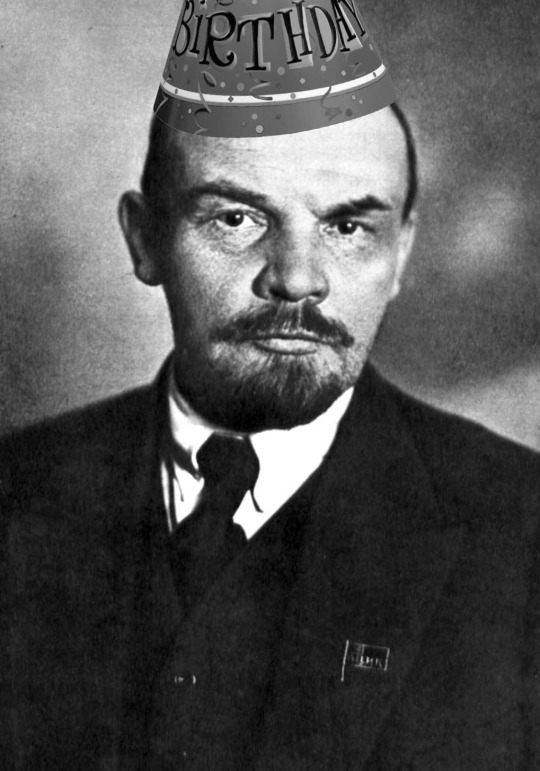
Happy birthday, Vladimir Lenin! (April 22, 1870)
One of the most relevant and influential revolutionary figures of the 20th century, Vladimir Lenin, birth name Vladimir Ilyich Ulyanov, was born in Simbirsk to a well-off family. Lenin's brother was himself a revolutionary, and his execution in 1887 for the attempted assassination of Tsar Alexander III spurred Lenin to embrace revolutionary socialist politics. He was eventually sent into internal exile in Siberia for his activities, before relocating to Western Europe. Lenin became a prominent figure in the Russian Social Democratic Party, and led the Bolshevik faction in the party's split, opposing the Menshiviks. During World War I, Lenin articulated the position of the international socialist movement's left wing, arguing that socialists should oppose their imperialist governments in wartime and work to convert the imperialist war into a war to enact the overthrow of capitalism. After the Tsar was overthrown in the February Revolution, Lenin returned to lead the Bolsheviks in Russia, and they soon seized state power in the October Revolution. The Social Democratic Party was soon reformed into the Communist Party, and Lenin led the new Russian Soviet Federative Socialist Republic in withdrawing from the world war, defeating the right-wing Whites in the Russian Civil War, and establishing the Soviet Union. Lenin also founded the Communist International in order for the international socialist movement to coordinate strategically. In the aftermath of the civil war, Lenin promulgated the New Economic Policy, which was intended to help the Soviet Union rebuild and develop its productive forces. Lenin died soon after the end of the civil war in 1924, and was ultimately succeeded as leader of the Soviet Union by Joseph Stalin. Lenin's developments to Marxist theory are known as Leninism, and his most prominent works include What is to be Done?, The State and Revolution, and Imperialism: The Highest Stage of Capitalism.
"The dictatorship of the proletariat, i.e., the organization of the vanguard of the oppressed as the ruling class for the purpose of suppressing the oppressors, cannot result merely in an expansion of democracy. Simultaneously with an immense expansion of democracy, which for the first time becomes democracy for the poor, democracy for the people, and not democracy for the money-bags, the dictatorship of the proletariat imposes a series of restrictions on the freedom of the oppressors, the exploiters, the capitalists."
668 notes
·
View notes
Text

“The first Erzyan scientist” – Tikhon Petrovich Mironov
Born in 1901 into a peasant family in the village of Kechushevo, Simbirsk Governorate (now Ardatovsky District of Mordovia). He graduated with honors from the Ardatov Gymnasium. In 1927-1928 he participated in linguistic expeditions of the USSR Academy of Sciences under the leadership of D.V. Bubrikh. He graduated from LILI and graduate school under him (1932). Since 1932 he has been a teacher of the Erzya language at the Mordovian Pedagogical Institute. At the same time, he worked as a research fellow at NIIMK, from where he was fired in 1933 for “distorting” the decisions of the 1st Language Conference, and a year later he was reinstated at the institute.
The first of the Erzya and Moksha linguists is a candidate of philological sciences. Defended his thesis “Tyengushevo (Shokshan) dialect as a result of crossing the Erzyan and Mokshan languages on an Erzyan basis.” Together with A.P. Ryabov and others developed uniform standards for the Moksha and Erzya languages; under the leadership of Mironov, the “Dialectological atlas of the Mordovian (Erzya and Moksha) languages” was compiled. In June 1937 he was arrested. Accused of belonging to the “Mordovian right-wing Trotskyist bourgeois-nationalist bloc” and of “espionage for Finland.”
A year later he was convicted and executed on May 23, 1938 in Saransk. Rehabilitated in 1956.
He will have time to write to his wife in the last message: “Believe, Olya, I am not guilty of anything, take care of the children...”.
3 notes
·
View notes
Text
Russia's Typhoon-Class Missile Submarine Is Something the Navy Can't Match
Russia's Typhoon-Class nuclear submarines were a vessel the U.S. Navy could never match in terms of size and total tonnage. They carried a massive amount of Nuclear Missiles.
— By Peter Suciu | Monday January 22, 2024

Image: Shutterstock
A Big Deal: The Russian Navy's Typhoon-Class — Nearly a year ago, Russia decommissioned the Project 941 Akula (NATO reporting name Typhoon) heavy nuclear-powered missile-carrying submarine cruiser Dmitry Donskoy several years earlier than expected. In fact, it had been only three years ago that the Kremlin announced the boat would remain in service until at least 2026, even as its role was reportedly limited to that of a weapons test platform for the new Borei-, Borei-A-, Yasen-and Yasen-M-class submarines.
In February 2023, it was officially confirmed that Dmitry Donskoy was decommissioned in February due to cost considerations. The submarine had served for more than 40 years in the Northern Fleet.
Initially designated the TK-208, she was the lead vessel of the Soviet third-generation Akula-class (Russian for "Shark"). She entered service in 1981 with the Soviet Navy, and after a 12-year overhaul and refit that began in 1990, she reentered service in 2002 as the Dmitry Donskoy, named after the Grand Duke of Moscow Dmitry Donskoy (1359–1389), the reputed founder of Moscow.
According to Russian media, Dmitry Donskoy initially carried D-19 strategic intercontinental ballistic missiles (ICBMs) as its basic armament. Following its upgrade under Project 941UM, it was involved in the tests of the seaborne Bulava ICBM.
Typhoon-Class: Project 941 Boats: The Sevmash Shipyard built six of a planned seven Project 941 submarines for the Russian Navy, and all were operational with the Northern Fleet. Though the oldest of the submarines, the Dmitriy Donskoy was also the last of the class to remain in service.
The TK-202, TK-12 – later renamed the Simbirsk – and T-13 were withdrawn from active service between 1996 and 2009, and scrapped with the financial support of the United States. Two other boats: the TK-17/Arkhangelsk and TK-20/Severstal remained in service until they were decommissioned circa 2013. A seventh boat, TK-210, was laid down but scrapped before completion.

With a displacement of 48,000 tons, a length of 175 meters (nearly 600 feet), a 23-meter beam, and a 12-meter draught, the Typhoon-class was the largest class of submarines ever built. Developed with multiple pressure hulls, including five inner hulls situated inside a superstructure of two parallel main hulls, the Typhoon-class was also wider than any other submarine ever built. The submarines were powered by OK-650 pressurized-water nuclear reactors, two 50,000 horsepower steam turbines, and four 3,200 KW turbogenerators and this provides the boat with the ability to sail at a speed of up to 22.2 knots on the surface and 27 knots whilst submerged.
Each contained nineteen compartments, including a strengthened module, which housed the main control room as well as an electronic equipment compartment above the main hulls and behind the missile launch tubes. It even was reported that there was a sauna on board as well as a small swimming pool for the crew. The sheer size of the submarines was likely welcomed by the approximately 160 sailors who called the submarine home on voyages lasting 120 days or longer, oftentimes without surfacing for months at a time.
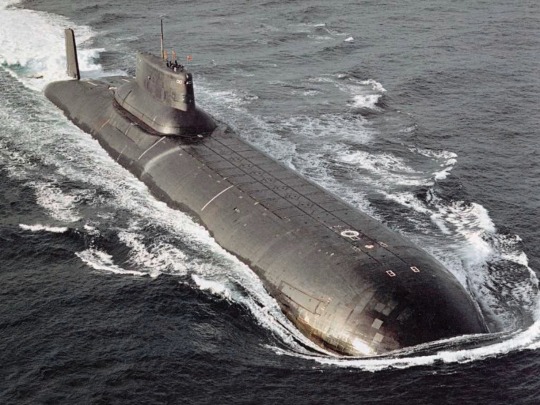
The Typhoon-class subs were designed to counter the United States Navy's Ohio-class subs, which were capable of carrying up to 192 100-kiloton nuclear warheads. By contrast, the Soviet Typhoons could carry a primary cache of 20 RSM-52 SLBMs (submarine-launched ballistic missiles), each of which contained up to 10 MIRV (multiple independently targetable reentry vehicle) warheads.

Though the Dmitriry Donskoiy has been decommissioned, in 2021, a new sub of the Borei-class has already begun construction; and when launched, will bear the name of the legendary founder of Moscow.
— Peter Suciu is a Michigan-Based Writer. He has contributed to more than four dozen magazines, newspapers, and websites with over 3,200 published pieces over a twenty-year career in journalism. He regularly writes about military hardware, firearms history, cybersecurity, politics, and international affairs. Peter is also a Contributing Writer for Forbes and Clearance Jobs.
#The National Interest#Magazine#Blogs#Military#Economics#Technology#Russia 🇷🇺#Typhoon-Class#Missile Submarine#Navy#U.S. Navy 🇺🇸#Nuclear Missiles#Peter Suciu#Typhoon-Class: Project 941 Boats 🛶 🛥️ 🚤#TheNationalInterest.Org
4 notes
·
View notes
Text

Mordovian girl. Simbirsk province. 1870
Мордвинка. Симбирская губерния. 1870
Carrick, William (photographer)
Каррик, Вильям (фотограф)
#indigenous russia#indigenous russian#non-russian#Finno-Ugric#Mordovia#Мордовия#Mordovian culture#Культура Мордвины
17 notes
·
View notes
Text

SHARSHUN Sergey Ivanovich 1888-1975 "Composition on the theme of a concert for harpsichord." Variation No. 14. 1957-1958. Oil on canvas. Size: 38x46 cm. In the lower right corner is the author's signature and date. On the back of the canvas there is an author's inscription. Silaev's expertise
Painter, graphic artist and writer. The eldest of four children of merchant Ivan Mikhailovich Sharshun, a Catholic, comes from Slovakia. Mother - Matrena Ivanovna Salamatina, from a merchant family. He spent his childhood in Buguruslan. Until 1907 he studied at the Simbirsk Commercial School. He unsuccessfully tried to enter the Kazan Art School.
In October 1909 he came to Moscow, studied in private studios of I. I. Mashkova and K. F. Yuona. I met M. F. Larionov, N. Village Goncharova, poet A. E. Twisted. In the autumn of 1910, he was drafted into the army. He deserted in 1912. He came to Paris through Poland and Berlin; he took up painting. He attended the Russian Academy and the Academy of La Palette, studied with A. Le Fauconnier, J. Metzenger and D. de Segonzac. In 1913-14 he showed the first cubist experiments ("Elastic compositions") in the salon of the Independents. He became close to the sculptor Elena Grynkhov, a student of A. Burdel and A. P. Arkhipenko.
Kardashidi and Art-Souz
9 notes
·
View notes
Text

Vladimir Vladimirovich (1837 - 1870) took part in the Caucasus campaigns and was governor of Simbirsk between 1866 and 1868. He was the son of Count Vladimir Petrovich Orlov-Davydov (1809 - 1882) and Olga Ivanovna Baryatinskaya (1814 - 1876).
5 notes
·
View notes
Text
Saturday 1 [Saturday 29 February] 1840
8
2 40/..
Long in washing etc. R12 ½° on my table at 10 a.m. breakfast over at 11 – Reading Schnitzler vol. 2 p. 684 et seq. government of Saratoff [Saratov] – had our landlord up – no steppe on this side the Volga – no eaux minérales here – they are at the Caucasus –
to go to Orenburg, must return to Simbirsk – 500v. from here to Uralsk
the éboulement – there was one in 1827 – one 3 years ago 2v. from here – a brandy distillery slipped away – only a brewery left there – the village is removed – belongs to government –
the slip last summer was at Féodorfka 250v. from here on the great road to Astrakhan no lives lost – 50 or 60 cottages slipped away –
Mr. Stalepine has no verrerie here
no Tartar mosques or schools here – the Botanic garden on the hill that we passed yesterday at 1st supposing it a vineyard – mulberry trees there – these were what we took for vines in the distance but on nearing them (never very near) they looked like orchid trees –
about 30,000 inhabitants – trade in fish and caviar – had just written so far at 12 55/.. – out at 1 ½ A- and I in a traineau and pair (good horses as at Kazan) along our street Rue de Moscou, some distance – then turned right, along the street where the post office is, and then into the great Astrakhan road for some way, and then left this and drove another road by which also one goes to A- in summer, and then to the Botanic garden! – a quiz upon Botanic gardens if this be one – the serres that Schnitzler mentions are a small wooden erection heated [entirely] but only for a few hydrangeas oleanders geraniums and 1 or 2 pair of viburnum huddled together on the floor – there were also a few bulbs or onions, - and in the lower part lettuces just come up – there must be some other botanic garden but the German colonist living there and inspector of the silk thread manufactory a little building near declared there was no other garden belonging to la ville – he shewed us a specimen of the silk thread – yellow and white – pretty good? good road here a day or 2 ago – now snowed up – our horses lunged sank deep (several times) and we had to get as we could up to the house – returned past the prison a large building full of people for Siberia – our barrier that we entered by close by – we kept outside and drove along the old town – the rue de tartars down upon the Volga close to the great ravine which parts the town in 2 and in the bot[tom] of which several brick-ovens and sheds – but saw nothing of the old rampart that Geo. Dictionary speaks of – on getting upon the river drove northwards to see the mountain slip of last summer – it is a little beyond (north) of the 4 lines of magasins à sel – the Sokolof [Sokolov] mountains aboutissent, and a bit of the end of this sandy range slipped off its marly [?] bed in the great heat of August last (said our driver) – and just beyond this (north) was the larger slip in 1827 – a mere Isle of Wright landship – no lives lost – then at 3 ½ drove across (5v.) to the Pokrofsky [Pokrovsky] slobode in ½ hour – drove to the salt warehouses (near our one of the 3 good churches in this village of peasants belonging to government) – a crowd of [?] – busy loading with the salt – sells here at 1/40 per
SH:7/ML/E/24/00029
pood and at the lake itself the people gather the salt then [?] and pay ./80 per pood for it – all broken pretty small – in very coarse grain – looked like a coarse dusky gravel – but good salt (tasted it) and in this state the peasants use it; but if they want fine salt, each can easily refine for himself by means of alum – then drove about the village – went in to the one of the little Isbas – apparently one of the worse – very small – always 2 rooms however small or they could not keep their living place warm enough the entrance room or vestibule is a sort of receptacle for everything – the inner room entered by a little low door that we had to creep in at, has the oven stove and shelf over it the bench and a table – a white calf lay by the stove – the man of the house on the bench in his dark coloured shirt, and a young girl or 2 on the stove – just room for all these people to turn themselves and not much more – the wife was not at home – the man put on his shube, and came out with wondering why we should trouble ourselves to peep into such a place – he looked pale – how could he do otherwise – the heat and smell of the little hot place were intolerable – but this man at his ease – 3 cows – a horse – some sheep, geese, pigs and poultry and a couple of telegas, and a willow wattled round farmyard like all the rest of the people – not a cottage without the like appurtenances – the village had a striking appearance thus full of wattled enclosures a great out-buildings for the cattle and many many of the huts of this sort of wicker work mud-plastered over – passed near to each of the 3 good churches and went into one of them – vespers – full of shubed people – the service well chaunted – beautiful singing – I could have staid longer but A- was cold and anxious to be off – we had put R on the now few minutes before (at 4 ½) and it stood at only -7 1/2° - but there was a cold wind – the church all painted in fresco was even handsome seemed spacious for a Greek church the nave from the belfry and the great dome being all church – the prestole in the Apsis behind the dome – square tower clocher, nave, Dome, apsis – such is the style of church here and all along since Kazan – the 5 dome churches are rare hereabouts, and the little domes where they exist are mere reminiscences – little things like 4 chimneys – very cold wind in our faces as we returned, and the snow blown up and driven about us – returned up our street (the main street – Rue de Moscou), but turned left to see the large cathedral planted round at a little distance with trees (young) along a nice walk here is the senate house – the large handsome house of Ivanof the [?] chez que the emperor stays when he comes – the clocher (at a little distance) is only about ½ built – the church is finished and has been finished did the man say 12 years – a largeish square finished in an inscribed circle
of 2 grades from the highest of which springs the large handsome dome – towards the clocher (west?) there is a hexastyle? and pediment – opposite (last?) is an apsis – the other 2 sides have each a hexastyle with architrave and cornice without pediment – this church standing on high ground is seen from far the most massive building in the town – as strikingly huge and massive here, as the new town hall is at Birmingham – came in at 5 ½ M. and Madame Stalapine had called – disappointed not to find us at home – had invited us to dinner tomorrow at 12 – at noon! the courier and Gross declared it was so – and they would send their carriage but had promised it yesterday to some friends – a great ball of the noblesse tomorrow night – ordered 2 horses to be put to our own kibitka – had the courier and George – from here to Astrakhan the posting sans pour boire = 280/. – to give the courier [100/.] tomorrow – he is to inquire if there is a road from here to Uralsk – the distance – road from thence to Orenburg and distance – from where to turn off to the Calmuck [Kalmyk] Encampment etc. etc. dinner at 6 ½ - a bottle of red Donskoi 1/. sweetish and pleasant and a bottle of white champagne-like Donskoi 3/. as yesterday – we finished the bottle as yesterday and sat over it till 8 – then lay down for a few minutes – could not be more than 8 ½ when Madame Stalepine called and staid till 10 – talked very agreeably – there is a better Inn than this – the hotel de Petersburg – I said the courier managed all these things – to dine at 4 p.m. tomorrow and the carriage to be sent for us – Mr. S- has 4000 peasants – one village = 1000 – [?] in sheep – has made a contract for 10 years with a Mr. Cowley fermier from not far from London who pays ½ expense and .:. takes ½ profits – M. S- finding (I conclude) the pasturage – has 60,000 arpens of land – Mr. Cowley has sent over an English shepherd who brought his young wife with him – arrived at St. P- in June last and here in September – the sheep by water to St. P- and ditto from there here – Mr. and Mrs. Cowley were here 2 or 3 months last summer he delighted with the place and would have been glad to remain here – the terre where the sheep are is 10v. from the next station from here on the Simbirsk road – not far .: from Volsk [Vol’sk] – we at our last station were 10v. from our compatriot shepherd and our English long fine wool sheep – one ram cost 600/. and one Ewe 200/. Mr. S- had 400 from England and several others of the Russian nobility of St. P- and elsewhere had sheep of the same kind so that a large flock must have come – Madame S- has 3 children the oldest aet. 5 – 2 girls and a boy – looks young – and prettyish – very civil – tea after she went away – then reading Dictionary geography till 1 and then till 2 10/.. wrote all but the first 13 lines of today – fine day but cold wind and cold this afternoon after between 2 and 3 p.m.
3 notes
·
View notes
Text
who says a 5"5 brunette from simbirsk cant develop the productive forces
1 note
·
View note
Link
Lenin: Rus Devriminden Sovyetler’e Giden Yol
Vladimir İlyiç Ulyanov, daha bilinen adıyla Lenin, 22 Nisan 1870’te Rusya’nın Simbirsk (bugünkü adıyla Ulyanovsk) şehrinde doğdu.
0 notes
Photo

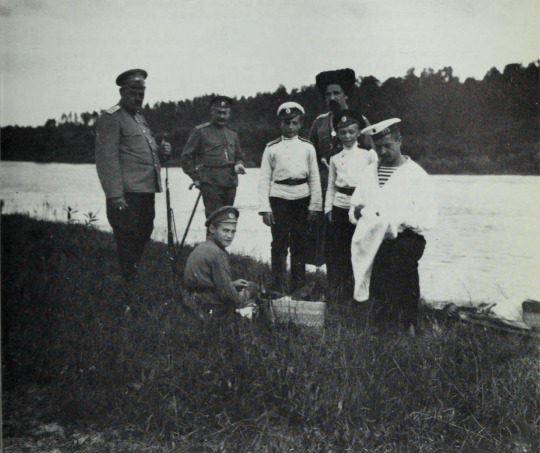

Cadets Evgeni Makarov and Vasili Agaev - Part X (Final in the series)
This is the last post of photographs which feature the Tsesarevich’s good friends, Cadets Evgeni Makarov and Vasili Agaev. These three photographs come from various sources (some of them unknown, as I’ve had these photographs saved for such a long time and have forgotten where some of them are originally from).
Cadets Makarov and Agaev (affectionately referred to as “Zhenya” and “Vasya” by the Tsesarevich, and his family), came to Stavka at Mogilev (General Headquarters) in mid-late Summer of 1916. In the Tsesarevich’s diary entries, his times spent at “HQ” were some of the happiest in his life. He felt the most freedom there as opposed to Tsarskoe Selo where he was surrounded always by “fussy women.”
________________________________________________________________
Photographs:
1. Tsesarevich Alexei Nikolaevich with Cadets Evgeni Makarov (back-ground, center, right) and Vasili Agaev (foreground, in profile, left), as well as, Sailor Klementy Nagorny (in profile, far left) and three other un-identified men.
2. Tsesarevich Alexei Nikolaevich with Cadets Evgeni Makarov (back-ground, right) and Vasili Agaev (back-ground, center), as well as, Sailor Klementy Nagorny (foreground, far right), Petr Petrov (far left), General Voeikov (back-ground, left) and an un-identified cossack (“The Last Tsar,” sourced below).
3. Tsesarevich Alexei Nikolaevich with Cadets Evgeni Makarov (center, with a bottle) and Vasili Agaev (center, left), as well as, Boatswain Andrei Derevenko (far left), Petr Petrov (right of Tsesarevich Alexei Nikolaevich) and Pierre Gilliard (far right).
________________________________________________________________
Sources:
“The Last Tsar.” - Virginia Cowles. Published, Circa. 1977.
Link of courtesy:
https://archive.org/details/lasttsar00cowl/page/219/mode/2up
#evgeni makarov#vasili agaev#simbirsk cadet corps#orlovsky-bakhtin cadet corps#tsesarevich alexei#alexei nikolaevich#romanov#imperial russia#photographs#1916#russian archival material#russian state archives#great war#first world war#tribute post
7 notes
·
View notes
Text
Stepan Erzya is a man who did not break the axe

Stepan Erzya at work.
Stepan Erzya is a man who did not break the axe. Biography of the sculptor
Stepan Erzya is not like most sculptors who use stone or metal as a material. Erzya preferred to turn wood into sculpture.
Stepan Erzya, a famous Russian sculptor, was born in 1876 in the village of Bayevo, then still in the Simbirsk province. His real name is Stepan Dmitrievich Nefedov, but he entered the history of art under the pseudonym “Erzya,” taken from the name of the Mordovian nation of the same name to which he belonged. One of the sculptor’s teachers was Konstantin Korovin (whose painting “Veranda” recently went at auction for 560 thousand euros).
Read the full article
0 notes
Text
Zum hundertsten Todestag von Lenin (1924–2024)
katholisches.info: Von Roberto de Mattei* Der hundertste Todestag von Wladimir Iljitsch Uljanow, bekannt unter dem Kampfnamen Lenin, einer der verbrecherischsten Persönlichkeiten der Geschichte, wurde von einer düsteren Atmosphäre umhüllt. Er starb am 21. Januar 1924 in Moskau an den Folgen eines Schlaganfalls, nachdem er 54 Jahre zuvor in Simbirsk am Westufer der Wolga geboren worden war. ... http://dlvr.it/T4M3WT
0 notes
Text

Mordovian man from Simbirsk Governorate and Mordovian woman from Penza Governorate, 1830s.
From ГИМ archive.
0 notes
Text
Vida y muerte de Lenin
Por Semanario Voz
En solo siete años Lenin fue capaz de instaurar y organizar el primer Estado Socialista en toda la historia de la humanidad. Construyó así lo que parecía una utopía de Marx
José R. Llanos H.
Vladimir Ilich Ulianov Lenin nació el 10 (22) de abril de 1870 en la ciudad de Simbirsk, hoy Ulianovsk, situada en las márgenes del río Volga. El 30 de agosto de 1918, Lenin sufrió un…

View On WordPress
0 notes